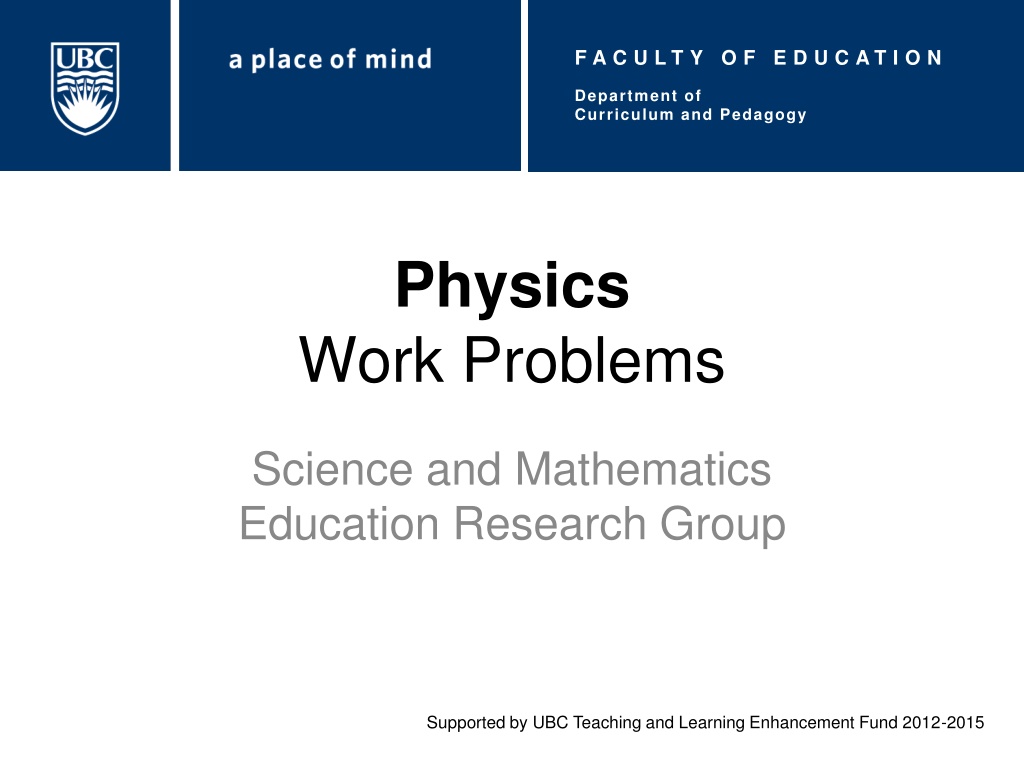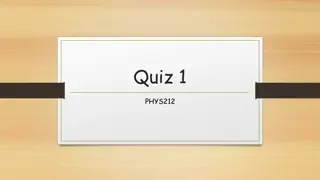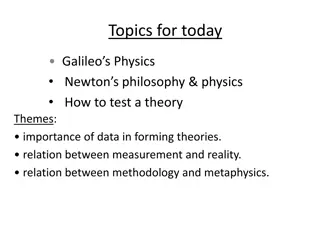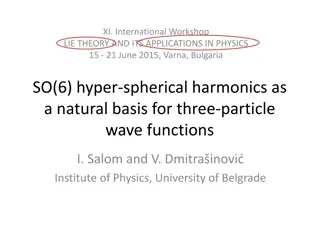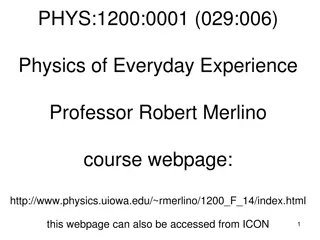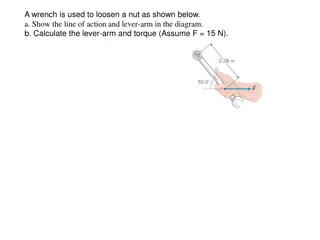Understanding Work Problems in Physics Education
This content delves into work problems in the context of physics education, exploring scenarios involving forces, motion, and work calculations. It includes questions, solutions, and explanations to help learners grasp the fundamental concepts of work in physics.
Download Presentation

Please find below an Image/Link to download the presentation.
The content on the website is provided AS IS for your information and personal use only. It may not be sold, licensed, or shared on other websites without obtaining consent from the author. Download presentation by click this link. If you encounter any issues during the download, it is possible that the publisher has removed the file from their server.
E N D
Presentation Transcript
FACULTY OF EDUCATION FACULTY OF EDUCATION F A C U L T Y O F E D U C A T I O N Department of Curriculum and Pedagogy Physics Work Problems Science and Mathematics Education Research Group Supported by UBC Teaching and Learning Enhancement Fund 2012-2015
Question Title Question Title Work Problems Retrieved from: http://sdsu-physics.org/physics180/physics180A/units/unit2/workandenergy.html
Question Title Question Title Work Problems The following questions have been compiled from a collection of questions submitted on PeerWise (https://peerwise.cs.auckland.ac.nz/) by teacher candidates as part of the EDCP 357 physics methods courses at UBC.
Question Title Question Title Work Problems I The same force F pushes in three different ways on a box moving with a velocity v, as the drawings show. Rank the work done by the force F in ascending order (smallest first): A. (A, B, C) B. (A, C, B) C. (B, A, C) D. (C, B, A) E. (C, A, B)
Question Title Question Title Solution Answer: E Justification: Work is maximized when the force is applied in the same direction as the movement. The greater the component of the force with the direction of motion, the greater the work. In C there is no work being done since the direction of the force is perpendicular to the direction of movement, and there is no component of force in the direction of movement. In A there is a component of force with the direction of motion. In B, the full force is in the same direction as the motion, and will therefore be doing the largest amount of work Therefore, the correct answer is E.
Question Title Question Title Work Problems II A box is lifted vertically 1.5 m and is then held there. The box has a weight of 100 N. Ignore friction. How much work is being done in holding the box in this elevated position? A. 150 J B. More than 150 J C. Less than 150 J D. No work is being done
Question Title Question Title Solution Answer: D Justification: You are not doing any work because you didn't move the box in any direction. With no displacement W = Fd = 0 J (Answer D). Yes, it does feel like you are putting work in just by holding a heavy box, but in physics the definition of work requires that a force causes a displacement in order for work to be done. Our bodies need to use chemical energy to hold the box up, and we are producing a force to keep it in the air. However, since the box is stationary, no work is done. If a table were to hold up the same box, it still wouldn't be doing any work.
Question Title Question Title Work Problems III A woman pulls a crate up a rough inclined plane at constant speed. Which statement is false? A. The work done on the object by gravity is zero B. The gravitational PE of the crate is increasing C. The work done by the net force acting on the crate is zero D. The work done on the crate by the normal force is zero
Question Title Question Title Solution Answer: A Justification: Let us look at all of the different options: A) The box is on an inclined slope, so the force of gravity is acts on the box at an angle. Therefore the work done by gravity is not zero because a component of the gravity force is in the opposite direction of the motion of the box being pulled up the incline. Since this is false, this is the right answer. Component of the gravity force parallel to the direction of motion Force of gravity
Question Title Question Title Solution continued B) As the crate is being pulled up the incline, the height of the crate above the ground is increasing, therefore increasing its gravitational PE. C) The net work done on the crate IS zero because the box is not accelerating. With no acceleration, there is no net force. With no net force, there is no net work done on the crate. D) The normal force is perpendicular to the motion of the crate, therefore the work done by the normal force is zero.
Question Title Question Title Work Problems III Two forces F1 and F2 with the same magnitude act on a particle along the same axis. As a result the speed of the particle increases in the positive direction. Which one of the following is NOT possible? A. The work done by F1 is positive, and the work done by F2 is zero. B. The work done by F1 is zero, and the work done by F2 is positive. C. The work done by each force is positive. D. The work done by each force is negative. E. The work done by F1 is positive, and the work done by F2 is negative.
Question Title Question Title Solution Answer: D Justification: For the particle speed to increase, the net work done to the particle must be positive. With a positive net work, there will be a positive net force that is applied to the particle (W = Fd). With a net positive force, there will be a net positive acceleration (F = ma), which will cause an increase in speed. This work cannot be negative because a negative work implies that the motion is in the positive direction but the work done in the opposite direction is slowing the object down. For an incorrect statement, the opposite is true: the net work done to the particle must be zero or negative. A) Positive work is done so this is incorrect. B) Positive work is done so this is incorrect. C) Positive work is done so this is incorrect.
Question Title Question Title Solution continued D) This is the right answer because a net negative work results, which will slow the particle down. E) We do not know the magnitudes of the work done, so F1 can be larger than F2, which results in a net positive work so this is incorrect.
Question Title Question Title Work Problems IV A 40.0 kg jogger runs up the slope described in the figure. She maintains a constant speed of 2.00 m/s for the entire path from point A to point D.
Work Problems IV Question Title Question Title continued What is the external power output of the jogger during her climb from point A to B? *The power is external because we are ignoring contributions form internal work such as maintaining body temperature* *Acceleration due to gravity is 9.82 m/s2* A. 786 J/s B. 524 J/s C. 436 J/s D. 393 J/s
Question Title Question Title Solution Answer: C Justification: This question is testing if you understand what power is and how to calculate the power of an object given the relevant information. This means that to calculate the power output of the jogger, we need to know the work done between point A and point B, and how long it took to do. One way that Work can be expressed is as the change in mechanical (Kinetic + Potential) energy of an object from one place/time to another.
Question Title Question Title Solution continued Does the kinetic energy of the jogger change from point A to point B? Since we are informed that the jogger maintains a constant velocity we can assume that there is no change in kinetic energy. Does the potential energy of the jogger change from point A to point B? Point A is 10 M lower than point B. Thus the jogger has gained some gravitational potential energy. The change in potential energy is equal to PEB PEA. By choosing to making the ground our zero for gravitational potential energy we simplify this expression by making PEA equal to zero. So our final expression is:
Question Title Question Title Solution continued 2 Next we need to calculate the time it takes for the jogger to move from point A to B. We are given the speed of the jogger as 2 m/s and the only missing piece of information is the length of her path. Since she moves along the slope of the hill the distance of the path is going to be the hypotenuse of the right triangle with sides 15 m and 10 m. We can calculate this distance using the Pythagorean theorem a2 + b2 = c2. The path length (d) from A to B is then: B d 10 m If our runner moves along that path at a rate of 2 m/s then the time it takes for her to reach point B is: A 15 m
Question Title Question Title Solution continued 3 Dividing the work done by the time it takes to do said work gives us: (Answer C) A is incorrect because it uses the change in height divided by the speed in order to determine the change in time. B is incorrect because it uses the horizontal distance form point A to point B in order to determine the change in time. D is incorrect because it uses the total length of the path in order to determine the change in the potential energy.
Question Title Question Title Work Problems V A 40.0 kg jogger runs up the slope described in the figure. She maintains a constant speed of 2.00 m/s for the entire path from point A to point D.
Work Problems V Question Title Question Title continued Compare the work done by and external power exerted by the jogger in the intervals A to B and C to D. *The power is external because we are ignoring contributions form internal work such as maintaining body temperature* *Acceleration due to gravity is 9.82 m/s2* A. PowerAB > PowerCD and WorkAB = WorkCD B. PowerAB < PowerCD and WorkAB = WorkCD C. PowerAB < PowerCD and WorkAB < WorkCD D. PowerAB > PowerCD and WorkAB > WorkCD E. PowerAB = PowerCD and WorkAB = WorkCD
Question Title Question Title Solution Answer: B Justification: This question can be answered without any calculations. Any work done by the runner will result in a change in the kinetic or potential energy of the runner. Since the velocity of the jogger is constant we know that none of the work done takes the form of kinetic energy and rather all of the work done goes into changing the potential energy of the jogger.
Question Title Question Title Solution continued For the next step in the question we need to remember that: All we need to do is figure out which section takes the longest amount of time for the runner to complete. By observation we can see that section AB is longer than section CD, and since the velocities are the same in both cases we can conclude that the time taken is longer for AB than it is for CD. Since work is the same in both cases, the power must be greater for CD and smaller for AB (inversely proportional to time). This gives us the answer that work is the same for both cases while the power output is larger for CD than it is for AB (Answer B).
Question Title Question Title Work Problems VI A 40.0 kg jogger runs up the slope described in the figure. She maintains a constant speed of 2.00 m/s for the entire path from point A to point D.
Work Problems VI Question Title Question Title continued What is the average external power output of the jogger during her run? *The power is external because we are ignoring contributions form internal work such as maintaining body temperature* *Acceleration due to gravity is 9.82 m/s2* A. 489 J/s B. 373 J/s C. 524 J/s D. 331 J/s E. 496 J/s
Question Title Question Title Solution Answer: B Justification: This question is trying to figure out if you understand what power is and how to calculate the average of power given the relevant information. There are two ways you could approach this problem. You could either find the total work and the total time and use these to calculate the average power (the easiest method) or you could find the power for each section and average your results. For the first method, we can use the fact that Work can be expressed as the change in mechanical (Kinetic + Potential) energy of an object from one place/time to another.
Question Title Question Title Solution continued Does the kinetic energy of the jogger change from point A to point D? Since we are informed that the jogger maintains a constant velocity we can assume that there is no change in kinetic energy. Does the potential energy of the jogger change from point A to point D? Point A is 20 M lower than point D. Thus the jogger has gained some gravitational potential energy. The change in potential energy is equal to PEB PEA. By choosing to making the ground our zero for gravitational potential energy we simplify this expression by making PEA equal to zero. So our final expression is:
Question Title Question Title Solution continued 2 Next we need to calculate the time it takes for the jogger to move from point A to D. We are given the speed of the jogger as 2 m/s and the only missing piece of information is the length of her path. To find the total time we need to add up the lengths of each segment (AB, BC, and CD) and divide by the speed at which the runner is moving. We already know the distance from A to B from the first question in this series (18 m). We can also see that section B to C is 10 m long. We can calculate the final distance from C to D using the Pythagorean theorem a2 + b2 = c2. The path length from C to D is then: D d 10 m C 10 m
Question Title Question Title Solution continued 3 Therefore the total length of the path from A to D is: 18 + 10 + 14.1 = 42.1 m If our runner moves along that path at a rate of 2 m/s then the time it takes for her to reach point D is: Note: Make sure that when doing these calculations, you use the full answers and not the approximations (keep the original numbers in your calculator) Note that the runner has no power output in section BC (since they do not change height and have constant velocity, and therefore do zero work), but it is still important to include this distance (and time) in our calculation for average power. Dividing the work done by the time it takes to do said work gives us: (Answer B)
Question Title Question Title Solution continued 4 If you approached the problem from the other perspective you would calculate the power for each section individually first. From the first question in this series, we already know the runner s power output during section AB to be 436 J Also, as mentioned earlier, the runner does no work in section BC (constant velocity means there is no change in kinetic energy, and she stays at the same height so there is no change in potential energy). Therefore the runner has no power output for section BC. For the last section CD, we can calculate the work done by the runner by looking at the change in potential energy. It is the same amount of work as done in section AB, since the height changed by the same amount (10 m). So we know the work done was 3928 J.
Question Title Question Title Solution continued 5 Then we can calculate the time it took for the runner to cover section CD. We already know the length of the path (14.1 m), and the runner s speed (2 m/s): We can then calculate the power for section CD: To calculate the average power for the whole trip all we need to do is take the weighted average (by time) of the powers for each section. We cannot just get a normal average of the powers from the three sections because the runner takes different amounts of time for each section. We know the time taken for each section: TimeAB = 9 s TimeBC = 5 s TimeCD = 7.1 s
Question Title Question Title Solution continued 6 And so we get: (Answer B) A is incorrect because using the first method the five seconds of zero power was not included in the total time. C is incorrect because it uses the horizontal length from A to D instead of the path length to determine total time. D is incorrect because it is the unweighted average of the powers. E is incorrect because it is the unweighted average of the non zero powers.
Question Title Question Title Work Problems VIII A water skier, moving at a speed of 9.30 m/s, is being pulled by a tow rope that makes an angle of 37.0 with respect to the velocity of the boat. The tow rope is parallel to the water. The skier is moving in the same direction as the boat.
Work Problems VI Question Title Question Title continued If the tension in the tow rope is 135 N, determine the work that it does in 12.0 s. A. 108 J B. 135 J C. 12 000 J D. 15 100 J
Question Title Question Title Solution Answer: C Justification: To answer this question it will help us to draw a simplified diagram of the situation: Since the skier is moving in the same direction as the boat, their displacement vector is at an angle of 37 to the force vector of the rope. Here we can use the equation: Displacement = ? We know the velocity of the water skier, and how long they travel, so we can work out their displacement:
Question Title Question Title Solution continued From there we can calculate the work done: Therefore the correct answer is C A) You will get this answer if you forget to multiply by the distance in the equation W = Fdcos B) This answer assumes that the skier travels 1 m with = 0 , and so W = 135 N 1 m = 135 J is not the right answer. C) You will get this answer if you forget to take the component of the force and multiply by cos .
